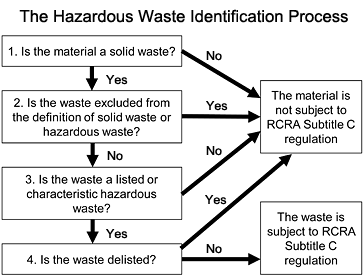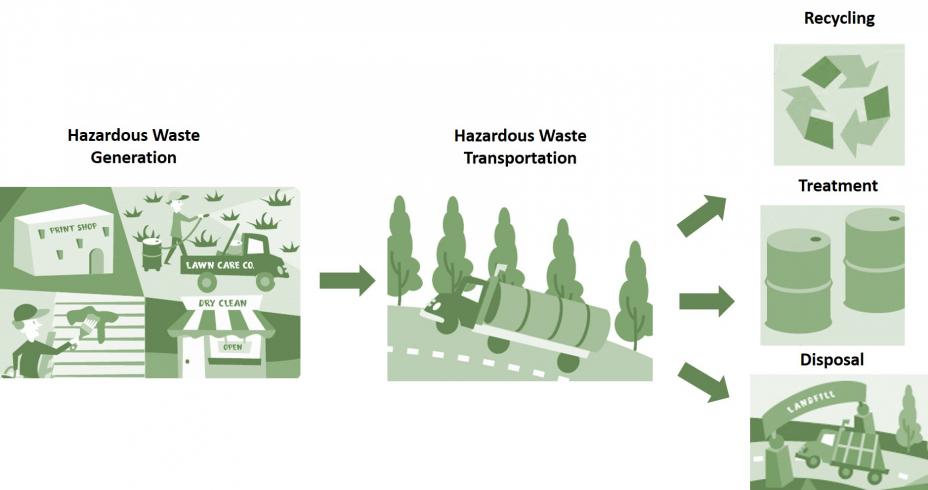Learn the Basics of Hazardous Waste
Hazardous waste that is improperly managed poses a serious threat to human health and the environment. The Resource Conservation and Recovery Act (RCRA), passed in 1976, was established to set up a framework for the proper management of hazardous waste.
On this page:
- What is a hazardous waste?
- The cradle-to-grave hazardous waste management process
- Regulations for specific wastes
- EPA hazardous waste initiatives
What is a Hazardous Waste?
Simply defined, a hazardous waste is a waste with properties that make it dangerous or capable of having a harmful effect on human health or the environment. Hazardous waste is generated from many sources, ranging from industrial manufacturing process wastes to batteries and may come in many forms, including liquids, solids gases, and sludges.
EPA developed a regulatory definition and process that identifies specific substances known to be hazardous and provides objective criteria for including other materials in the regulated hazardous waste universe. This identification process can be very complex, so EPA encourages generators of wastes to approach the issue using the series of questions described below:
 Click on a step in the hazardous waste identification process for more information.
Click on a step in the hazardous waste identification process for more information.In order for a material to be classified as a hazardous waste, it must first be a solid waste. Therefore, the first step in the hazardous waste identification process is determining if a material is a solid waste.
The second step in this process examines whether or not the waste is specifically excluded from regulation as a solid or hazardous waste.
Once a generator determines that their waste meets the definition of a solid waste, they investigate whether or not the waste is a listed or characteristic hazardous waste. Finally, it is important to note that some facilities petitioned EPA to delist their wastes from RCRA Subtitle C regulation. You can research the facilities that successfully petitioned EPA for a delisting in Appendix IX of Title 40 of the Code of Federal Regulations part 261.
Select a question below to learn more about each step in the hazardous waste identification process.
- Is the material in question a solid waste?
- Is the material excluded from the definition of solid waste or hazardous waste?
- Is the waste a listed or characteristic hazardous waste?
- Is the waste delisted?
EPA’s Cradle-to-Grave Hazardous Waste Management Program
In the mid-twentieth century, solid waste management issues rose to new heights of public concern in many areas of the United States because of increasing solid waste generation, shrinking disposal capacity, rising disposal costs, and public opposition to the siting of new disposal facilities. These solid waste management challenges continue today, as many communities are struggling to develop cost-effective, environmentally protective solutions. The growing amount of waste generated has made it increasingly important for solid waste management officials to develop strategies to manage wastes safely and cost effectively.
RCRA set up a framework for the proper management of hazardous waste. From this authority, EPA established a comprehensive regulatory program to ensure that hazardous waste is managed safely from "cradle to grave" meaning from the time it is created, while it is transported, treated, and stored, and until it is disposed:
 RCRA's Cradle-to-Grave Hazardous Waste Management System
RCRA's Cradle-to-Grave Hazardous Waste Management System
Hazardous Waste Generation
Under RCRA, hazardous waste generators are the first link in the hazardous waste management system. All generators must determine if their waste is hazardous and must oversee the ultimate fate of the waste. Furthermore, generators must ensure and fully document that the hazardous waste that they produce is properly identified, managed, and treated prior to recycling or disposal. The degree of regulation that applies to each generator depends on the amount of waste that a generator produces.
EPA provides detailed online information about the regulations applicable to generators of hazardous wastes.
Hazardous Waste Transportation
After generators produce a hazardous waste, transporters may move the waste to a facility that can recycle, treat, store or dispose of the waste. Since such transporters are moving regulated wastes on public roads, highways, rails and waterways, United States Department of Transportation hazardous materials regulations, as well as EPA's hazardous waste regulations, apply.
For more information on requirements pertaining to this issue, visit EPA’s Web page on hazardous waste transportation.
Hazardous Waste Recycling, Treatment, Storage and Disposal
To the extent possible, EPA tried to develop hazardous waste regulations that balance the conservation of resources, while ensuring the protection of human health and environment. Many hazardous wastes can be recycled safely and effectively, while other wastes will be treated and disposed of in landfills or incinerators.
Recycling hazardous waste has a variety of benefits including reducing the consumption of raw materials and the volume of waste materials that must be treated and disposed. However, improper storage of those materials might cause spills, leaks, fires, and contamination of soil and drinking water. To encourage hazardous waste recycling while protecting health and the environment, EPA developed regulations to ensure recycling would be performed in a safe manner.
Treatment Storage and Disposal Facilities (TSDFs) provide temporary storage and final treatment or disposal for hazardous wastes. Since they manage large volumes of waste and conduct activities that may present a higher degree of risk, TSDFs are stringently regulated. The TSDF requirements establish generic facility management standards, specific provisions governing hazardous waste management units and additional precautions designed to protect soil, ground water and air resources.
Comprehensive information on the final steps in EPA’s hazardous waste management program is available online, including Web pages and resources related to:
- Hazardous waste recycling,
- Regulations that apply to treatment, storage and disposal facilities, and
- Descriptions of land disposal restrictions.
Regulations for Specific Wastes
EPA has tried, to the extent possible, to develop regulations for hazardous waste management that provide adequate protection of human health and the environment while at the same time:
- fostering environmentally sound recycling and conservation of resources,
- making the rules easier to understand,
- facilitating better compliance, or
-
providing flexibility in how certain hazardous waste is managed.
Thus, EPA created alternative management standards for certain types of wastes including:
- Academic Laboratory Wastes
- Cathode Ray Tubes (CRTs)
- Household Hazardous Waste
- Mixed Radiological Wastes
- Polychlorinated Biphenyls (PCBs)
- Solvent-Contaminated Wipes
- Special Wastes
- Universal Waste
- Used Oil
EPA Hazardous Waste Initiatives
After decades of experience with the current system, EPA is looking forward and examining how the hazardous waste program should evolve to meet the new challenges and opportunities of this century. EPA is leading the nation in moving toward that future now by:
